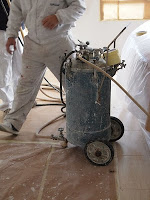
As indicated in the previous post, the fireplace and chimney-breast were removed, giving more space in the living-room. The wall, of course, retained a huge scar, with a smaller one in the ceiling, so it was now time for the painters to come in and do their bit.
The two painters arrived on Monday morning and prepped the whole thing, covering all necessary areas with masking tape and brown paper; the air-conditioning unit was wrapped up like a Christmas present and the windows were also largely covered with brown paper (we had decided to have the walls around the windows painted, too, as the original paint was flaking there).

Painting walls is rather more complex than it sounds here in Spain. Walls are often not smoothly painted here, but instead are finished with a rough texture. This is achieved by first spraying a thick paste onto the wall in the form of tiny droplets. Once dried, the now rough surface is painted in the desired colour. The paste that is used to form the droplets is held in a large, bomb-like contraption, which is connected to a compressor. Once sufficient pressure has built up in the "bomb", an adjustable nozzle is used to direct the droplets to the wall. I must admit, this all seems like a lot of extra work to me, but the resulting effect seems to be appreciated here, though it makes reverting back to a smooth surface a real bind.

By mid-day on Monday, the prepping and droplet-spraying had been completed, so the painters left in order to allow the droplets to dry sufficiently for the actual painting, which would take place the next day. That went very smoothly, with two coats of quick-drying paint put on with brush and roller. Once the painting had been completed, the two painters removed all the masking tape and brown paper, and even mopped the floor carefully and thoroughly.
They had worked well and done a good job.

There is but a fine trace of where the chimney used to be, which is cunningly hidden by a large framed silk painting.
Numerous photos, following the progress of the demolition and repainting, can be seen at
this Picasa album.
 We were in the El Corte Inglés store in Elche today (yes, again) and I came across a jar of paté in the health-food section.
We were in the El Corte Inglés store in Elche today (yes, again) and I came across a jar of paté in the health-food section.









